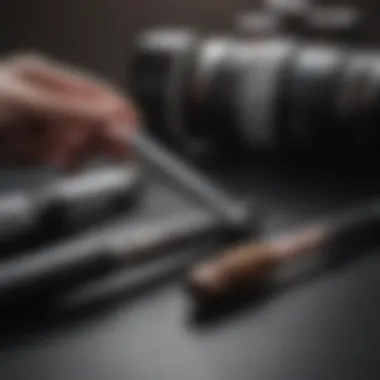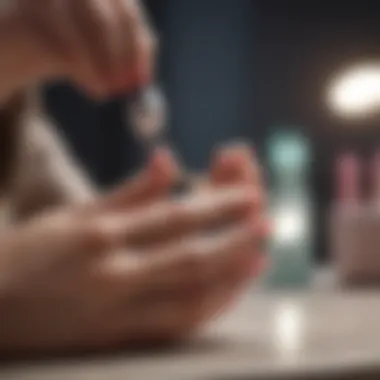How to Safely Remove Dip Powder Nails at Home


Intro
Dip powder nails offer a long-lasting and resilient manicure option. However, the removal process can determine nail health and aesthetics in the long run. Learning how to take off dip powder nails correctly is essential, whether opting for a home removal or seeking a professional service. This comprehensive guide unfolds the techniques needed for safe removal, addresses potential challenges, and outlines best practices to prevent nail damage.
Through detailed analysis, this article aims to improve one’s knowledge and confidence in dip powder nail care. Additionally, it highlights common tools and techniques necessary for the removal process.
Key Trends
Overview of Current Fashion Trends
The world of nails continues to evolve with new styles and approaches. Recently, dip powder nails have gained traction due to their vibrant colors and durability. The ease of application further boosts their popularity. As trends shift, understanding the lifecycle of nails becomes important, especially when it comes to maintenance and removal practices.
Popular Beauty Trends
Nail care has intertwined with overall beauty trends. More people focus on health and sustainability in beauty products. Many now consider the ingredients used in dip powder formulations. Also, the rise of DIY nail care at home drives innovation in removal techniques and tools. Integrating proper nail care into beauty routines reflects an informed approach to self-expression and wellness.
Tools Required for Removal
To remove dip powder nails effectively, certain tools are necessary. Here are the essentials:
- Nail file
- Acetone or a dip powder remover
- Cotton balls or pads
- Aluminum foil
- Cuticle oil
- Nail buffer
These tools facilitate a smoother process and help protect nail health throughout.
Step-by-Step Guide to Remove Dip Powder Nails
- File the Top Layer: Begin by gently filing the top layer of the dip powder. This helps acetone penetrate better in the next steps.
- Soak Cotton in Acetone: Soak a cotton ball or pad in acetone. Apply it to the nail and wrap with aluminum foil to keep it in place.
- Wait: Allow the acetone to work for about 10 to 15 minutes. This step is crucial; patience will yield the best results.
- Check Progress: After waiting, check one nail. If the dip powder is lifting easily, remove the foil. If not, reapply and wait a few more minutes.
- Gently Scrape Off: Once the dip powder softens, gently scrape it off with a wooden stick. Avoid excessive force to prevent damaging the nail.
- Buff Your Nails: After all dip powder is removed, buff the nails gently to smooth out any rough spots.
- Moisturize: Finish by applying cuticle oil. This will help restore hydration to the nails and surrounding skin.
"Proper removal is as essential as application. Ensuring nail health is paramount to loving your manicure choices."
Beauty Tips for Healthy Nails After Removal
- Stay hydrated by drinking enough water.
- Apply nail strengthener periodically.
- Maintain a consistent cuticle care routine.
By following these steps and tips, you will each time enhance your nail care routine and prolong the health of your nails. The knowledge shared here equips you to tackle dip powder removal with ease and confidence.
Prelude to Dip Powder Nails
Dip powder nails have become increasingly popular in recent years, providing a durable and visually appealing alternative to traditional nail polish. This section aims to introducе and articulate the essential elements surrounding dip powder manicures, the benefits they offer, and key signs indicating when it’s time for removal.
Understanding Dip Powder Manicures
Dip powder manicures are a technique that involves the application of a base coat followed by dipping the nails into colored powder. This process bonds the powder to the nail with the help of a special topcoat. The result is a strong and vibrant finish. This method has gained traction for its ease of application and longer-lasting wear compared to regular nail polish.
It is important to note that while dip powders can be attractive, they do adhere to the nail more firmly than traditional methods, making removal crucial for maintaining overall nail health. Understanding this aspect helps users appreciate both the allure and responsibility that comes with having dip powder nails.
Benefits of Dip Powder Nails
Dip powder nails offer various advantages that appeal to many. These include:
- Longevity: With proper application, dip powder nails can last several weeks without chipping or fading.
- Quick Drying: Unlike regular polishes that require time to air dry, dip powders cure quickly, allowing for a more efficient process.
- Variety of Colors: There are numerous shades available, providing options for anyone looking to express their personal style.
- Strength: Dip powder nails tend to be more durable than traditional acrylics or gels, making them resistant to breakage.
These benefits have made dip powder manicures a preferred choice for many individuals looking for practicality and aesthetic appeal in their nail care routines.


Signs It’s Time to Remove Dip Powder Nails
It’s crucial to monitor the condition of dip powder nails to determine when removal is necessary. Some signs that indicate it might be time to take off the dip powder nails include:
- Fading of Color: If the vibrancy of the nails diminishes, it's a good time to consider a fresh application or removal.
- Chipping or Lifting: Noticing any lifting or chipping is a clear indicator that the manicure is failing.
- Nail Health Concerns: If the natural nail appears damaged or discolored underneath the dip powder, this signals the need for removal.
Paying attention to these signs not only serves to maintain the look of nails but also promotes overall nail health. Attention to detail in this regard is essential, as neglect can lead to more significant issues down the line.
Preparing for Removal
Before embarking on the journey of removing dip powder nails, it is crucial to prepare adequately. This preparation not only ensures the process is more efficient but also minimizes the risk of damaging your natural nails. Having the right tools at hand will facilitate a smoother removal, making it less of a task and more of an easy ritual. Moreover, setting up a safe workspace is vital to prevent mishaps due to spills or mess from the removing process. Being well-prepared helps boost confidence and ensures an effective removal experience.
Gathering Necessary Tools
Gathering the necessary tools is the first step in preparing for dip powder removal. The right equipment is essential for a successful and stress-free experience. Each tool serves its own purpose, contributing to the removal process while protecting the health of your nails.
Acetone or Non-Acetone Remover
Acetone is the most commonly used solvent for removing dip powder nails. It breaks down the dip powder quickly, making the removal faster. It is important to note that acetone can be drying to the nails and skin. Non-acetone removers, while gentler, may require a longer soaking time. Non-acetone options usually contain nourishing ingredients or oils, making them a decent alternative if you are concerned about drying out your natural nails. However, keep in mind that they might not be as effective as acetone.
Nail File
A nail file plays a significant role in the preparation phase. This tool helps thin down the top layer of dip powder before soaking. A finer grit file minimizes damage to the natural nail during this step. Using a nail file effectively can lead to quicker removal. Be careful to avoid aggressive filing, as this may weaken the nail bed. Consider a glass or crystal file for a gentler approach that creates less friction.
Cuticle Pusher
A cuticle pusher is essential for gently pushing back the cuticles and can also assist in scraping off any lifted dip powder after soaking. It is a gentle yet effective tool for aiding removal. A stainless steel option is durable and easy to clean, ensuring hygiene during your nail care routine. Be mindful to use this tool delicately to avoid damaging your nail bed or cuticles.
Cotton Balls or Pads
The choice between cotton balls or pads is another small yet important detail. Both absorbent materials work well when soaked in your chosen remover. Pads may provide a more consistent thickness, while cotton balls can be easier to handle for wrapping around your nails. Choose what feels most comfortable for you.
Aluminum Foil
Aluminum foil serves as an excellent tool to keep the soaked cotton tightly secured to the nails. Its flexibility allows you to mold it easily around your fingers. This helps create a conducive environment for the acetone to work effectively, ensuring a thorough removal. Opt for a heavy-duty foil, as it will hold its shape better and reduce the chances of accidental spills during the process.
Setting Up a Safe Space
Creating a safe space is more than setting up a table; it encompasses ensuring that your environment is clean and equipped with everything you need. Consider using a surface that can manage any potential spills from acetone or nail dust. Having all your tools neatly arranged will keep distractions to a minimum and the process more efficient.
Step-by-Step Removal Process
The step-by-step removal process is integral to ensuring that dip powder nails are taken off safely and effectively. Each step plays a crucial role in preserving the health of your natural nails. Failing to follow these steps can lead to damage, discomfort, and overall nail health deterioration. This process ensures you understand the significance of taking your time and using the right techniques.
Filing the Top Layer
Begin by filing the top layer of the dip powder nails. This step is essential as it removes the shiny top coat and reduces the thickness of the powder. A coarse nail file works best for this task. Begin by gently filing the surface of each nail without applying too much pressure, as this can harm your natural nail underneath. Aim for an even surface to ensure better absorption during the soaking phase.
Soaking the Nails
Soaking the nails is a pivotal step in the removal process. The goal is to dissolve the dip powder effectively, making it easier to remove from the nail.
Using Acetone
Acetone is the most commonly used solvent for removing dip powder nails. It effectively breaks down the dip powder's compounds due to its strong solvent properties. This has led to its popularity among users.


The key characteristic of acetone lies in its fast-acting nature. With just a few minutes of soaking, it starts working to dissolve the powder. However, it is important to note that acetone can be harsh on the skin and nails. Thus, users should take precautions, such as applying hand cream or cuticle oil before soaking, to mitigate dryness. Although it is for many the go-to option, its potential to weaken nails if overused cannot be ignored.
Alternatives to Acetone
For those seeking gentler options, alternatives to acetone exist. Many nail salons now offer non-acetone removers. These tend to be milder on the skin and nails. One notable characteristic of non-acetone removers is their coconut or vitamin-rich formulas, which help in maintaining nail health.
Using these alternatives can be beneficial in that they produce less intense fumes, making the experience more pleasant. However, one downside is that they may require more time to soak before they successfully break down the dip powder layers. The choice between acetone and non-acetone will depend on personal sensitivity and preferences regarding nail health and comfort.
Wrapping with Foil
Once the nails are adequately soaked in your chosen remover, wrapping them with aluminum foil aids in retaining heat. The heat enhances the solvent's ability to break down the powder. Use small squares of foil and cotton balls soaked in acetone or non-acetone remover. Place the cotton on each nail and wrap the foil tightly around it. This method can significantly improve the effectiveness of the soaking process by preventing evaporation, allowing for a safer and more efficient removal.
Checking on the Soak
After wrapping your nails, it is important to periodically check the progress. Set a timer for around 10-15 minutes, after which gently press on the foil. If the dip powder appears to be softening, it may be time to remove the foil. If not, give it a little longer. Regular checks help ensure that you do not over-soak or risk damaging your natural nails.
Removing the Dip Powder
After the soaking has done its job, it is time to remove the dip powder. Start by gently pushing the powder off using a cuticle pusher. Be careful not to force it, as that can lead to nail damage. If necessary, re-soak any areas that are still resistant. Once all the powder is removed, finish by washing your hands to eliminate any residue left from the remover. This will help in keeping your nails and cuticles healthy and residue-free as you transition to the next phase.
Post-Removal Care
Post-removal care is crucial in maintaining the health and appearance of your nails after you have removed dip powder. This stage involves several important steps that contribute to recovery and rejuvenation. Neglecting post-removal care can lead to weakened nails, dryness, or other unwanted effects, making it essential to prioritize proper care.
Assessing Nail Health
After removing dip powder nails, the first step is to assess your nail health. Check for any signs of damage, such as brittleness, splitting, or peeling. Healthy nails should feel smooth and resilient. If you notice any irregularities, it may be a sign that your nails require more attention. Understanding your nails' condition can help you determine the best course of action to restore their strength and appearance.
Nourishing Your Nails
Nail Oils
Nail oils can be a valuable component of your post-removal routine. These oils often contain ingredients that deeply hydrate and nourish the nails and surrounding skin. One of the key characteristics of nail oils is their ability to penetrate the nail bed, promoting moisture retention. This makes them a popular choice for individuals caring for their nails after removal processes.
A unique feature of nail oils is their formulation that often includes natural oils, such as jojoba, argan, or vitamin E, which aid in strengthening nails. While they are generally a beneficial option, some may find that oil application can leave hands feeling greasy if not used carefully.
Moisturizers
Moisturizers play an important role in post-removal care as well. Applying a moisturizer to your hands and nails helps combat dryness that may result from the soaking and removal process. The primary characteristic of moisturizers is their ability to lock in hydration, thereby keeping the skin soft and supple.
Many moisturizers contain nourishing elements like shea butter or glycerin, making them effective for enhancing overall skin health. Though they are advantageous, they must be chosen carefully because some products may contain irritants that can adversely affect sensitive skin after removal.
Preventing Future Damage
To prevent future damage to your nails, it is important to adopt protective practices in your nail care routine. For example, always wear gloves while doing household chores to minimize exposure to harsh chemicals. Regular nail trims can also help maintain their strength. Additionally, avoiding excessive use of nail products can reduce stress on the nail structure. With thoughtful prevention strategies, you can keep your nails looking healthy and vibrant long after removal.
Professional Removal vs. DIY
When deciding between professional removal of dip powder nails and a do-it-yourself (DIY) approach, several factors come into play. Each option carries its own set of benefits and considerations. It is crucial to weigh both sides to make an informed decision.
Professional nail technicians possess the training and experience to safely remove dip powder nails without compromising the health of the underlying nails. They have access to specialized tools and products that may not be readily available to the average person. Moreover, a skilled technician can recognize specific issues such as nail damage or infection and can suggest appropriate methods to address them. Professional removal is particularly beneficial for individuals who have very thick or damaged dip powder nails, as the removal process can vary depending on the severity of the condition.
On the other hand, DIY removal can be a cost-effective alternative. With the right tools and techniques, many individuals can successfully remove dip powder nails at home. However, caution is necessary. An improper technique might result in damage, irritation, or even pain during and after the process. Understanding the safe methods and tools is vital for those choosing the DIY route.
Ultimately, the decision between professional help and DIY should involve careful consideration of the individual’s skills, experience, and the condition of their nails.


When to Seek Professional Help
There are specific scenarios where professional help is highly recommended. If the dip powder nails have been on for an extended period, the natural nails underneath may need special attention. Over time, dip powder can cause the nails to weaken or become damaged. A technician can assess the overall nail health and determine the best course of action. Additionally, if there are any visible signs of nail infections, such as swelling, discoloration, or pain, it is crucial to seek expert assistance rather than attempting removal at home.
Complex situations, such as the presence of ingrown nails or if the dip powder is the result of an allergic reaction, also warrant professional removal.
Cost Considerations
Cost is another factor to think about. Professional removal at a salon varies widely in price based on the location, the reputation of the salon, and the expertise of the technician. On average, clients might expect to pay anywhere from $20 to $50 for the service. This cost often includes additional pampering, such as a nail care treatment.
For those who opt for a DIY approach, the initial investment in necessary tools may be lower, but consider that repeated purchases of acetone, cotton pads, and any other materials can add up over time. If individuals are planning to have dip powder nails frequently, investing in quality tools for DIY removal becomes essential, as this can save money in the long run.
In summary, reflect on both the immediate costs and the long-term value of either professional services or DIY removal in relation to nail health.
Common Mistakes to Avoid
Understanding common mistakes in the dip powder nail removal process is crucial. Avoiding errors not only aids in effective removal but also preserves your nail health. Mistakes can lead to damage or prolonged discomfort. In the following sections, each mistake will be examined in detail, outlining reasons to be cautious and methods to ensure that your removal process is safe and effective.
Over-soaking the Nails
One of the primary mistakes people make is over-soaking the nails in acetone. Many believe that leaving nails in the solution for a longer time will ease the removal process. However, prolonged exposure can weaken nail structure. It dries out the nails and surrounding skin, leading to brittleness and peeling.
Set a timer when soaking your nails. Ideally, twenty minutes is sufficient to allow the acetone to break down the dip powder effectively. After soaking, gently check if the dip powder has begun to lift. If not, a shorter soak followed by more targeted removal methods is better than lengthy soaking sessions.
Using Incorrect Tools
Another frequent mistake is using incorrect or inadequate tools. Some think that a regular file or even household items can replace specialized nail tools. However, using inappropriate tools can lead to nail damage. For instance, a regular nail file may not effectively remove dip powder and could cause excessive friction.
It is important to have the right tools at hand. Ensure you have a proper nail file, a cuticle pusher, high-quality acetone or non-acetone remover, and aluminum foil. These tools are designed for safe and effective removal. Investing in them is part of maintaining good nail health.
Rushing the Process
Lastly, rushing the removal process is a significant mistake. In the desire to be done quickly, people might skip steps or apply force during removal. Rushing can result in tears in the nail bed or even damage to the surrounding skin. Patience is needed; haste can lead to longer-lasting issues.
Take time to prepare and follow all steps thoroughly. This includes filing, soaking, checking on progress, and gently pushing off the dip powder. Proper diligence will lead to a healthier nail outcome in the long run.
Remember, taking the time to remove dip powder nails correctly can save you from long-term damage and promote healthier nails.
Culmination
In summarizing the methods for removing dip powder nails, it becomes clear that careful preparation and understanding of the process are essential. This article highlighted the importance of using the right tools, such as acetone or non-acetone remover, nail files, and aluminum foil, to simplify the removal while protecting nail health.
Best practices include:
- Filing the top layer: This minimizes the soak time needed, making the process more efficient.
- Soaking properly: Whether one chooses acetone or an alternative, ensuring the nails are adequately soaked without overdoing it preserves the integrity of the nails.
- Taking time during removal: Rushing can lead to damage and discomfort. It's wise to check on progress regularly and be patient.
These strategies not only help in successfully taking off dip powder nails but also play a role in maintaining the nail's appearance and health.
Proper nail care post-removal is crucial to prevent dryness and brittleness. Applying nourishing products is a must.
Summarizing Best Practices
To ensure smooth removal of dip powder nails, adhere to these steps:
- Prepare your tools: Gather everything before starting—acetone, cotton balls, and aluminum foil should all be accessible.
- File gently: Lightly file down the top layer without damaging the natural nail below.
- Soak adequately: Use acetone or its alternative wisely. An even and thorough soak will allow for easier removal.
- Wrap properly: Ensure that the soaked cotton ball is sealed tightly with foil.
- Check progress: Be attentive but gentle when testing if the dip powder is coming off.
- Nourish after removal: Apply cuticle oil and moisturizer to replenish moisture and support nail recovery.
Final Thoughts
Removing dip powder nails can seem daunting. However, with the knowledge shared in this guide, women of all ages can confidently navigate the process. Careful preparation and patience are central to successful removal.
Moreover, understanding when it's advisable to seek professional help can save one from potential mishaps at home. As we conclude this discussion, remember that proper removal not only enhances the appearance of nails but significantly contributes to their health over time. Do not compromise on care—after all, healthy nails are happier nails.



